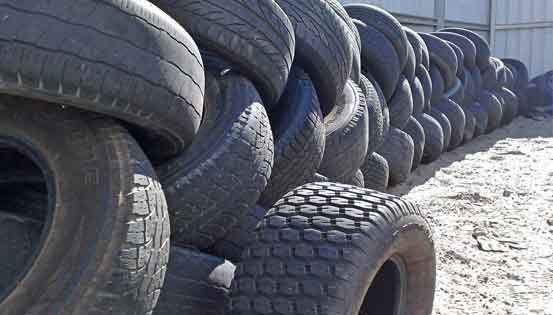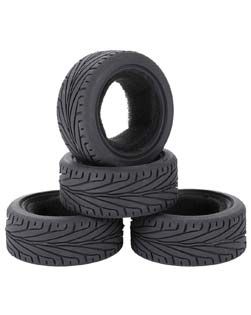About 75% of rubber is used up in the manufacturing of rubber tires. A tire or tyre is a device used for covering the circumference of a wheel. It is a covering of a wheel, made of rubber reinforced with cords of nylon, fiberglass, or other materials. It is filled with compressed air. A rubber tires are an essential part of most ground vehicles. A tires can dampen the oscillations caused by irregularities in the road surface, protect the wheel from wear and tear and at the same time provide a high-friction bond between the vehicle and the ground to improve acceleration and handling. There are various types of rubber tyres with maximum inflation pressure retention for truck, agricultural, industrial and specialty tires as well as cycle tyres, casters etc.
Properties of rubber tyres- A rubber wheel is a continuous pneumatic rubber and fabric cushion encircled and fitted onto the rim of a wheel.
- Chemicals are also compounded into the rubber to help the tyre to withstand wear, heat, and aging and to produce desired changes in its characteristics.
- Rubber gives the tire body strength and resilience.
- In belted tires, additional layers of fabric such as rayon, finely drawn steel, fiber glass etc. are placed just under the tread rubber or rim to increase mileage and handling.
- Steel wire is used in the bead or rim of the wheel that holds the tire to the rim.
- A rubber tyre resists wear and abrasion.
Buying tips for rubber tyres
For quality control purposes, sellers of rubber tires should know the
position of the steel or fiber ply cords that are embedded in the walls
of automobile, truck, and off-road vehicle tires. This is very important
in the case of the large, expensive tires that are used for heavy trucks
and construction equipments in which improper cord positioning can lead
to expensive failures. In some cases, buyers will also want to measure
total wall thickness. Because of the complex pattern of echoes that are
generated by the internal structure of most tires and because rubber is
very attenuating to high frequency sound waves, these measurements
require special consideration.


Parts of rubber tires
Tyre made up of two parts:
- The tread or road-contacting part: This is the part of the tire which provides traction and resists wear and abrasion.
- The body or carcass part: This is the part consisting of rubberized fabric. This gives the tire strength and flexibility.
There are three basic types of rubber tyres:
- Bias Tires: Cords in the piles extend diagonally across the tire from bead to bead in case of bias tires. The cords run in opposite directions in a crisscross pattern.
- Belted Bias Tires: For belted bias tires, plies are placed in the same manner as bias tire. The difference is that the belts of material are placed circumferentially around the tire between the plies and the tread rubber.
- Radial Tyres: For these kind of tires, cords in the plies extend transversely from bead to bead and are perpendicular to the direction of travel.
Tyres are used in all sorts of vehicles. The small segment vehicle tires combine top performances in terms of safety, driving stability and mileage. There are tires for medium-duty and heavy trucks and buses which are characterized by the latest technologies such as high mileages, reliable power transmission and low consumption of fuel. There are motorcycle tyres as well as bicycle tires. Tires are also used in any small movable objects like a trolley or a wheel chair. Accordingly we classify rubber tyres as follows:
- Anti Vibration Mountings
- Automobile Rubber Products
- Calendered Rubber Products
- Extruded Rubber Products
- Medical Rubber Products
- Metal Bonded Components
- Rubber Adhesives & Sealants
- Rubber Ball
- Rubber Bands
- Rubber Beading
- Rubber Bearing
- Rubber Belt
- Rubber Buckets
- Rubber Bullets
- Rubber Cable
- Rubber Coating
- Rubber Duct
- Rubber Expansion Joints
- Rubber Flooring/Matting
- Rubber Footwear
- Rubber Gloves
- Rubber Injection Parts
- Rubber Lining
- Rubber Magnets
- Rubber Molded Products
- Rubber Pads
- Rubber Rollers
- Rubber Stopper
- Rubber Suit
- Rubber Track
- Rubber Valve
- Rubber Balloon
- Rubber Stamps
- Rubber Fenders
- Acrylic Rubber (ACM)
- Butadiene Rubber (BR)
- Butyl Rubber (IIR)
- Chlorosulfonated Polyethylene(CSM)/ Hypalon
- Ethylene Propylene Diene Monomer
- Fluoroelastomers (FKM)/Viton
- Isoprene Rubber (IR)
- Nitrile Rubber (NBR)
- Perfluoroelastomer (FFKM)
- Polychloroprene (CR)/Neoprene
- Polysulfide Rubber (PSR)
- Silicone Rubber (SiR)
- Styrene Butadiene Rubber
How to Make a Custom Rubber Stamp?
Whenever designing a custom stamp for your company, never compromise on its quality because in the end it is the most...
Read MoreLatex and Silicone Rubber Tubing - A Comparison!
Many industries use rubber tubing for various purposes. In fact, various types of rubber tubing are used for different applications...
Read MoreSilicone vs Acrylic Adhesive- A Comparison
Silicon and acrylic adhesives are those rubber adhesives that are widely used in Polyimide tapes. In fact, the polyimide...
Read More

